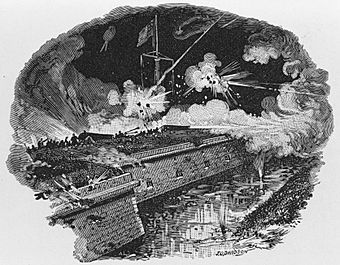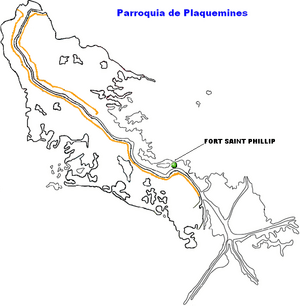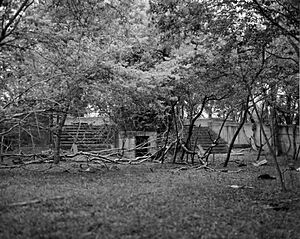Fort St. Philip facts for kids
|
Fort St. Philip
|
|

Fort St. Philip in the U.S. Civil War
|
|
| Lua error in Module:Location_map at line 420: attempt to index field 'wikibase' (a nil value). | |
| Location | Plaquemines Parish, Louisiana, US |
|---|---|
| Nearest city | Triumph, Louisiana |
| Built | 1746 |
| NRHP reference No. | 66000380 |
Quick facts for kids Significant dates |
|
| Added to NRHP | October 15, 1966 |
| Designated NHL | December 19, 1960 |
Fort St. Philip is a historic stone fort located in Plaquemines Parish, Louisiana. It sits on the eastern bank of the Mississippi River, about 40 miles (64 km) upriver from its mouth. Right across the river is Fort Jackson. This fort was built to protect the city of New Orleans, which is about 80 miles (129 km) further up the river. It also guarded the lower part of the Mississippi River.
Contents
Fort St. Philip: A Historic Louisiana Fort
Early Days of Fort St. Philip
The very first fort built at this spot was called Fort San Felipe. It was constructed in the 1700s. At that time, the area of Louisiana was controlled by Spain.
Fort St. Philip in Major Wars
War of 1812
Fort St. Philip played an important role in protecting the United States during the War of 1812. This war was fought against the British. In January 1815, the fort faced a ten-day battle. British Navy ships attacked the fort by bombarding it. This was their last attempt to invade Louisiana. The British Army had already been defeated near New Orleans. However, Fort St. Philip held strong and defended itself against the attacks.
American Civil War
Later, a new fort was built on this site. It was constructed along with Fort Jackson. These forts were designed to defend New Orleans and the Mississippi River. This happened because Andrew Jackson strongly suggested it.
During the American Civil War, Fort St. Philip was attacked again. In April 1862, Union forces laid siege to the fort for twelve days. This battle was very important. It led to the capture of New Orleans by the Union.
Later Uses and Current Condition
In 1960, Fort St. Philip was recognized as a National Historic Landmark. This means it is a very important historical site in the United States.
In the 1930s, the fort was used for a different purpose. It became a factory that processed animal hides into leather.
During the Civil Rights Movement, a local leader named Leander Perez used the fort. He tried to stop people from protesting against segregation. In 1964, he even put up barbed wire around the fort.
From 1978 to 1989, the fort complex was home to a spiritual community. This group was called Vella-Ashby. Around 16 people lived there at a time. They lived in buildings that were left over from when the fort was strengthened in 1898. These buildings included officers' quarters and an officers' club.
Today, Fort St. Philip is still privately owned. It is in poor condition and falling apart. In 2005, it was badly damaged by Hurricane Katrina and Hurricane Rita. According to the National Park Service, only the original brick fort and some concrete structures from the 1898 period remain.
You can only reach the fort by boat or helicopter. A small levee that protected it has eroded. This means the fort now floods when the Mississippi River water levels are high.
Images for kids
See also
 In Spanish: Fort Saint Phillip (Luisiana) para niños
In Spanish: Fort Saint Phillip (Luisiana) para niños





